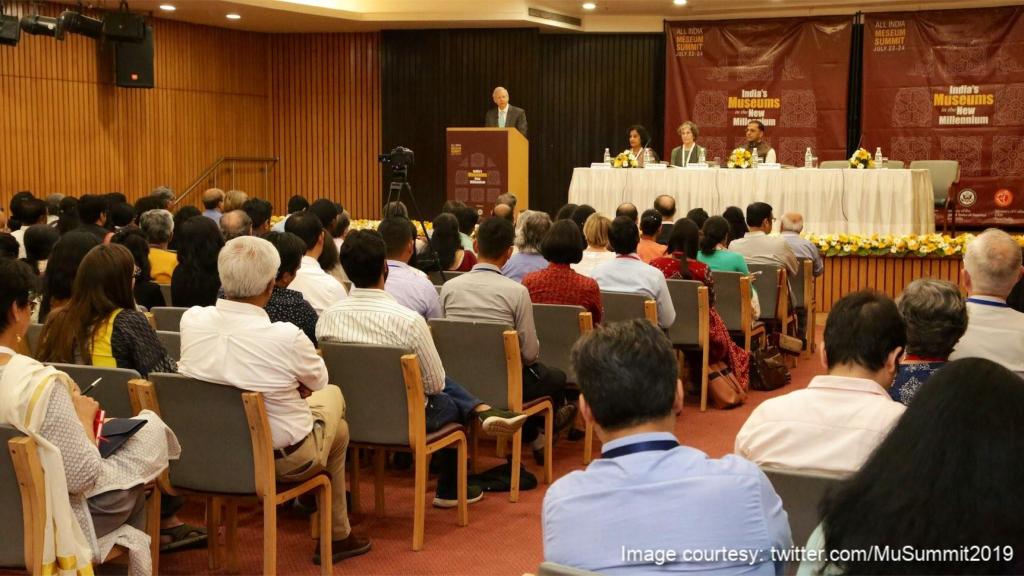July saw three conferences/summits that focused on museums, and a few more are lined by for the second half of the year. One such summit was the All Indian museum summit, organized by the American Institute of Indian Studies and funded by the American consulate and the Ministry of Culture, in Delhi from 22ndto 24thJuly 2019. The main objective of the summit was to initiate dialogue between the museum fraternity and collectively discuss challenges as well as possible solutions. These suggestions were then to be presented to the culture ministry in a form of a white paper. A summary of the panel discussions at the summit is provided below.
Day 1
The morning panel saw representation from four relatively new museums – Bihar Museum, MP Tribal Museum (Bhopal), Partition Museum, and Museum of Art and Photography. The state and private museums spoke about their journey thus far, highlighting their aims, challenges they faced, and strategies to combat these, going ahead. The Bihar museum was a result of the government’s realization that economic development was possible through harnessing their rich history (and subsequent tourism). The Partition museum was born out of a need to record an important part of our national history. While the community and ownership seen in the Tribal museum was commendable, the labelling of the museum as a tribal museum itself does need to be relooked as the term carries a lot of colonial baggage.
The afternoon sessions revolved around the present state of museology and challenges faced in loaning exhibitions. The lack of job opportunities and the various barriers faced by students entering the sector and the lacuna in the area of research, internships and mentoring were some of the areas that were highlighted. Museum directors spoke about the difficulty they faced in getting international exhibitions to India (like the high loan fee and lack of reciprocity). One got to hear the other side of the story as well, through hearing about the decision-making process foreign museums use for identification of whom to loan exhibitions to. The Q and A brought to light one of the key factors in this process, the importance of maintaining proper conservation standards, a practice that only few museums in India follow.
Day 2
The morning session revolved around constituencies, audience and access. Prof. Amareshwar Galla’s talk emphasized the importance of a national cultural policy on museums, citing US and Australia as examples. He also raised concerns about how the term ‘cultural heritage management’ is loosely used in India. Additionally, crucial questions about what is national in the National Museum and what is Indian in the Indian museum were raised. Former cultural secretary Jawhar Sircar pointed out the lack of an indemnity scheme and the urgency of having one especially if one wishes to see more international exhibitions. Shobita Punja recommended a museum art education policy to develop ideas and best practices, along with a strong evaluation process in art education.
Day 3
The third day revolved around different aspects of collection – care, documentation and research. The collections care, management and conversation session had experts from the field sharing their knowledge about the practices they used. The urgency for more conservation training centres across the country was highlighted. Realizing collections potential through research showcased different case studies that the speakers had used to engage with the collections. “What does the image/object want?”, “What happens when objects without research are to be displayed?” and “What gets conserved?” were some of the questions raised. However, most of these questions do not have immediate or short answers.
While problems were spoken about, concrete solutions weren’t necessarily arrived at. However, some important suggestions were:
– Revising the Antiquity Act of 1972
– Introduction of an indemnity policy and culture policy (related to museums)
– Addition of more conservation labs
With more platforms emerging, allowing for museum professionals to network, share and discuss ideas, many opportunities arise that need to be explored. One can hope that such events foster collaboration and collective problem solving, and that the ‘white paper’ translates into something substantial that changes the way museums engage with culture and policy work.

Tejshvi Jain is the Founder-Director of ReReeti. Over the last 15 years, she has curated shows, taught at colleges and published articles in several media. Her expertise lies in visitor engagement and audience development. She holds the Art Think South Asia Fellowship 2013-14 and the NTICVA UK Visiting Fellowship 2017-18.
ReReeti works with museums, galleries and heritage sites across India to plan strategies, design systems and implement programmes to increase audience engagement and institutional/ company visibility. Email us at info@rereeti.org for a free consultation or to collaborate on an upcoming exhibition.








Recent Comments